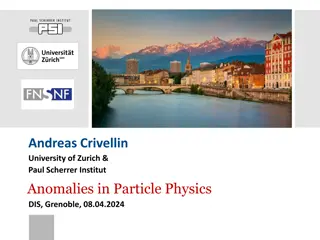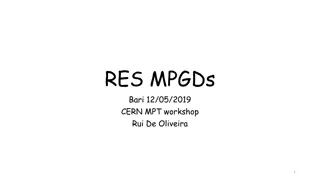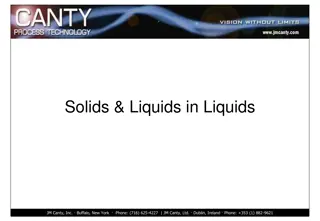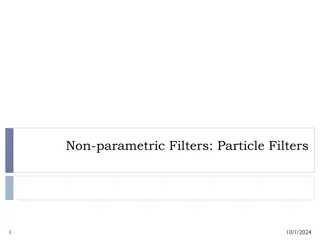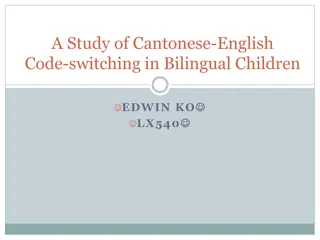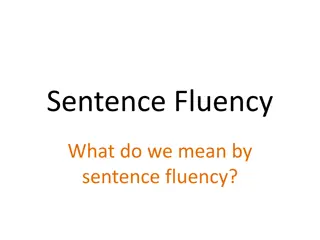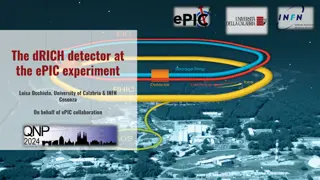Analysis of the Cantonese Sentence Particle "ge2
"ge2" is a sentence-final particle in Cantonese used for emphasis, uncertainty, and puzzlement. It can alter the secondary meaning of a sentence, illustrating lexicality, commitment, and speaker-orientation aspects. The study delves into examples and empirical data to understand its linguistic functions in depth.
Download Presentation

Please find below an Image/Link to download the presentation.
The content on the website is provided AS IS for your information and personal use only. It may not be sold, licensed, or shared on other websites without obtaining consent from the author.If you encounter any issues during the download, it is possible that the publisher has removed the file from their server.
You are allowed to download the files provided on this website for personal or commercial use, subject to the condition that they are used lawfully. All files are the property of their respective owners.
The content on the website is provided AS IS for your information and personal use only. It may not be sold, licensed, or shared on other websites without obtaining consent from the author.
E N D
Presentation Transcript
LT4216 Advanced Topics in Linguistics - CI Analysis of "ge2" Group 4 Kan Ka Ho, Arthur Lo Tsz Yan, Kate Lui King Yan Karen Wu Ming Chun, Strode
Introduction (ge2) is a sentence final particle in Cantonese Used in assertions when the speaker wants to make an emphasis It also adds uncertainty or puzzlement to the sentence
Warming Up A: B: A: HK boy B: HK girl A: ? A: Wanna go for Japanese cuisine tonight? B: Ok B: Ok (ge2) A: ? A: After that, shall we watch a horror movie? B: B: Fine (ge2) A: , , ? A: I haven t received my salary and you have B: to pay first. You don t mind, right? B: I don t mind (ge2)
Warming Up A: B: A: HK boy B: HK girl A: ? A: Wanna go for Japanese cuisine tonight? B: Ok B: Ok (ge2) A: ? A: After that, shall we watch a horror movie? B: B: Fine (ge2) A: , , ? A: I haven t got my salary and you have to B: pay first. You don t mind, right? B: I don t mind (ge2)
Summary of empirical data We will use the following sentence as an example sou1-saan1 Susan hai6 is leng3 ge2. beautiful SFP. - At-issue meaning : Susan is beautiful. - Secondary meaning : The speaker does not fully agree with the at-issue meaning (i.e. Susan is beautiful, in this case).
Lexicality - The secondary meaning was induced by ge2 only - If deleted, the secondary meaning does not exist - The sentence can still finish without this word - Lexicality is fulfilled sou1-saan1 Susan Meaning : Susan is beautiful. hai6 leng3. is beautiful.
Commitment - The secondary meaning shown cannot be cancelled - Commitment is fulfilled *sou1-saan1 Susan hai6 leng3 ge2. is beautiful SFP. ngo5 zan1-hai6 gok3-dak1 keoi5 hai6 leng3 I truly think she is beautiful. * Susan is beautiful. I truly think she is beautiful. .
Speaker-orientation - The speaker makes a contribution to the utterance by the word ge2. - Embed the sentence under an attitudinal verb secondary meaning still arises as both parts are speaker s opinion contradicted with each other Speaker-orientation is fulfilled bie2-dak1 ge2. gok3-dak1 sou1-saan1 hai6 leng3 Peter thinks SFP. Susan is beautiful daan6 ngo5 gok3-dak1 sou1-saan1 leng3.
Independence of what is said - Homer is negating the proposition: Susan is beautiful (at-issue) - No matter Susan is beautiful or ugly, the secondary meaning still arises - Independence is fulfilled Bart:sou1-saan1 hai6 leng3 ge2. Susan SFP is beautiful Homer: m4-hai6 co3 , geoi3 je5 hai6 ! No, the statement is wrong!
Proposal Hypothesis: - The Cantonese Sentence Final Particle : ge2 carries a secondary meaning: The speaker does not fully agree and such secondary meaning is a conventional implicature (CI) Prediction: - ge2 should demonstrate characteristics which are unique to CIs (e.g. invariant under holes, plugs)
1. Lexicality Formal Analysis 2. Commitment 3. Speaker-orientation 4. Independence of what is said
Our focus sentence Janice Man (JM) : dou1 ngo5 hai6 pou2 tung1 jan4 ge2 JM Example At-issue: I am also an ordinary person. Secondary: The speaker (i.e. I) does not fully agree that I am also an ordinary person.
Lexicality - ge2 is of type < ta, tc> type which contains the output of type tc - CI meaning comes from the word with CI type only CI application
Lexicality (contd) - If we delete ge2, only at-issue application can be applied At-issue application (all the way)
Commitment The CI collection rule ensures that if is of type (extensionally, ) then is interpreted as an entailment of the sentence. the at-issue proposition be(also(an(ordinary(person)))(I):ta Input p.does-not-fully-agree(the speaker)(p):<ta,tc> Result Does-not-fully-agree(the speaker)(be(also(an(ordinary(person))))(I)):tc
Commitment Note that Does-not-fully-agree(the speaker)((be(also(an(ordinary person))))(I)) Type:tc Therefore, the meaning ge2 is interpreted as an entailment of the sentence(i.e. commitment), which will be interpreted against the speaker s model
Commitment & Speaker-orientation Parsetree interpretation: < (be(also(an(ordinary(person))))(I)) Mj,g: ta, (does-not-fully-agree(the speaker)(be(also(an(ordinary(person))))(I))) Mj,g: tc> -Mj : Interpreted in the speaker s model (i.e. in Janice Man s model in this case) speaker-oriented & speaker s commitment
Speaker-orientation Potts (2003): - CIs cannot combine with higher intensional operators - CIs are interpreted as if they were root-level assertions interpreted relative to the speaker ONLY cannot be embedded under attitudinal verbs (e.g. believe) E.g. *bie2-dak1 soeng1-seon3 ngo5 dou1 hai6 pou2-tung1 jan4 ge2. * Peter believe SFP *Peter believes I am also (an) ordinary person . I also am ordinary person
Speaker-orientation (contd) *Not permitted: believe taking the at- issue meaning as argument BUT the CI meaning is still interpreted in the speaker s model CI cannot be taken as argument in LCI invariably speaker oriented
Independence of what is said Potts(2003) CI application yields a pair of expressions (at- issue&CI) Each computation is interpreted independently by parsetree interpretation
Conclusion Our hypothesis predicted that ge2 is a Conventional Implicature in Cantonese It fulfils the 4 criteria defined by Potts, as shown in the formal analysis 1) Lexicality 2) Commitment 3) Spearker-Orientation 4) Independence of what is said Our hypothesis makes the correct predicton
References Potts, Christopher. 2003. The Logic of Conventional Implicatures: UC Santa Cruz dissertation. 2016 10 22 [Video file]. (n.d.). Retrieved November 5, 2016, from https://www.youtube.com/watch?v=hBHZN6Jsa0k (Producer). (n.d.). 100 Reenex [Video file]. Retrieved November 5, 2016, from https://www.youtube.com/watch?v=hhZuf2kd2gI Apple Daily (Producer). (n.d.). Dickson https://www.youtube.com/watch?v=rkmSuiu8fzM [Video file]. Retrieved November 5, 2016, from Apple Daily (Director). (n.d.). JM [Video file]. Retrieved November 5, 2016, from https://www.youtube.com/watch?v=eoAVRQWnNNw&feature=youtu.be
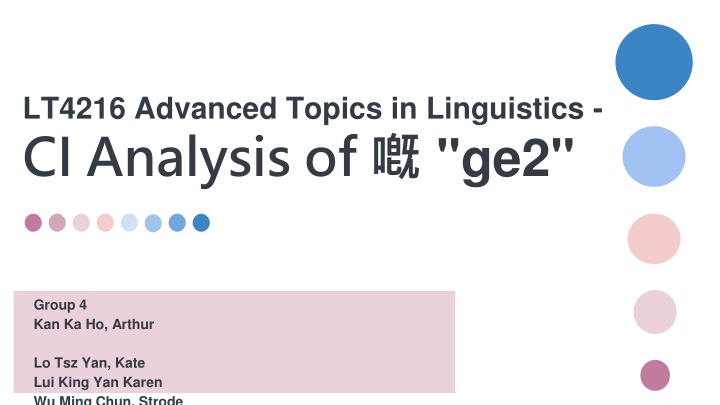

![[PDF⚡READ❤ONLINE] Cosmology and Particle Astrophysics (Wiley-Praxis Series in As](/thumb/21627/pdf-read-online-cosmology-and-particle-astrophysics-wiley-praxis-series-in-as.jpg)




